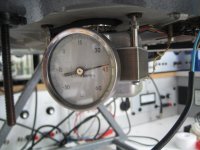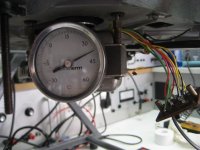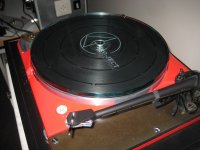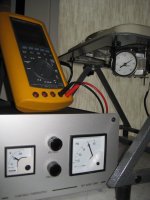I suspect under load they run considerably warmer, I would swag perhaps in the 55 - 60 degree C range.
I think you have to test also under full load* conditions. Then we can compare an unloaded test versus loaded and see if motor speeds are as consistent. Expect somewhat lower rpm under load but compare the cold versus warm same as done under no-load conditions.
* on a fully operational TD124.
-Steve
Quote:
Originally Posted by user510 View Post
I think you have to test also under full load* conditions. Then we can compare an unloaded test versus loaded and see if motor speeds are as consistent. Expect somewhat lower rpm under load but compare the cold versus warm same as done under no-load conditions.
* on a fully operational TD124.
-Steve
Yes but thats not so easy because to measure the speed from the motor you must have room to measure when it sits on his place.
I expect that the difference is not so much the motor slip become a little bit more and depents from the eddy current brake , idler/platter.
But I shall try it maybe I can measure the belt speed on the underside from the chassis.
Volken
I think what is called for is a fully restored drive train within a suitable td124 chassis. All motors to be tested would be temporarily mounted to this single chassis for the readings.
As to the method to pick up temperatures and rpm, I presume this isn't as convenient as it is on your test stand that we have seen in the past. Hopefully it is possible. With this kind of testing we can determine both motor behaviors under load and without load, and also the affects of a full load placed on the motor. And then the same testing regimen on motors with old coils versus motors with new upgraded coils from Simone.
I want to see what I already suspect, that TD124 units that have motors with ancient coils, even though all else has been refurbished, won't perform like a new turntable.
-Steve
Synchronus motors run at the drive frequency.
They slip slightly along the phase but no further.
If the load changes the slip changes.
So we can get dynamic slip changes with loading.
Induction motors run at drive frequency less a slip.
This induction motor slip is with reference to the unloaded theoretical speed.
This slip changes with loading, but does not have a limit.
As with the synchronous motor the dynamic slip changes with loading.
The less power we draw from both types of motors the less slip.
The more constant the power draw, the less the variation in speed and slip.
A powerful motor driving a low friction system will slip less and stay closer to the theoretical speed than a less powerful motor.
They slip slightly along the phase but no further.
If the load changes the slip changes.
So we can get dynamic slip changes with loading.
Induction motors run at drive frequency less a slip.
This induction motor slip is with reference to the unloaded theoretical speed.
This slip changes with loading, but does not have a limit.
As with the synchronous motor the dynamic slip changes with loading.
The less power we draw from both types of motors the less slip.
The more constant the power draw, the less the variation in speed and slip.
A powerful motor driving a low friction system will slip less and stay closer to the theoretical speed than a less powerful motor.
Exactly, plus.
The Eddy break in the TD-124 adds a lot of loading, much more than the events during the reading of the record.
So that the speed remains theoreticaly constant and unaffected by the stylus drags.
The Eddy break in the TD-124 adds a lot of loading, much more than the events during the reading of the record.
So that the speed remains theoreticaly constant and unaffected by the stylus drags.
The eddy brake does not interact with the loading of the stylus.
It is a set and forget to allow tuning of the speed relative to mains frequency.
If mains frequency changes, or dynamic loading changes, then the motor speed will change.
The eddy brake does not compensate for these effects.
It is a set and forget to allow tuning of the speed relative to mains frequency.
If mains frequency changes, or dynamic loading changes, then the motor speed will change.
The eddy brake does not compensate for these effects.
Newbie questions. If load an eddy's brake imposes is more than the variable load of stylus drag, will the slip remain constant ? How much influence would a heavy platter have on slip changes ? Wouldn't the inertia of rotating heavy platter over come various factors affecting speed accuracy ?
Thanks and regards.
Thanks and regards.
Thorens TD124 E50 motor temperature and speed
Following measurements under same conditions as first one hot measurement after two hours and speed measurement on the belt , the only way to measure the speed from the under side , hum shield removed.

Motor from ser.1487 speed 428,5 rpm cold at 42 degr. 427 rpm

Motor coil Simone 2 speed 436,6 cold at 38 degr. 435,6 rpm

Motor MK2 speed 429,6 cold at 37 degr. 426,0 rpm
Volken
Following measurements under same conditions as first one hot measurement after two hours and speed measurement on the belt , the only way to measure the speed from the under side , hum shield removed.

Motor from ser.1487 speed 428,5 rpm cold at 42 degr. 427 rpm

Motor coil Simone 2 speed 436,6 cold at 38 degr. 435,6 rpm

Motor MK2 speed 429,6 cold at 37 degr. 426,0 rpm
Volken
Following measurements under same conditions as first one hot measurement after two hours and speed measurement on the belt , the only way to measure the speed from the under side , hum shield removed.
View attachment 438301
Motor from ser.1487 speed 428,5 rpm cold at 42 degr. 427 rpm
View attachment 438302
Motor coil Simone 2 speed 436,6 cold at 38 degr. 435,6 rpm
View attachment 438303
Motor MK2 speed 429,6 cold at 37 degr. 426,0 rpm
Volken
Is the motor driving a completely assembled TD124. ie: belt driving stepped pulley driving the idler wheel driving the inside rim of the platter?
-Steve
Is the motor driving a completely assembled TD124. ie: belt driving stepped pulley driving the idler wheel driving the inside rim of the platter?
-Steve
Yes Steve driving completely TD124 !
Volken
Newbie questions. If load an eddy's brake imposes is more than the variable load of stylus drag, will the slip remain constant ? How much influence would a heavy platter have on slip changes ? Wouldn't the inertia of rotating heavy platter over come various factors affecting speed accuracy ?
Thanks and regards.
If I place a Project Glass platter will not change the speed !
Volken

I suspect under load they run considerably warmer, I would swag perhaps in the 55 - 60 degree C range.
These temperature values indicate that there is something wrong with the motor.
Normal values are around 40 degree !
Volken
I haven't measured it, but in a plinth with limited air flow I would expect them to run somewhat warmer. (SWAG = some wild ***** guess)
Also have you tested on the 100 - 125V tap where only half of the overall windings are used, and the motor is used as a step up for the 220V neon lamp? Given 1/4 the winding inductance at half the voltage, I suspect the winding losses are appreciably higher even at 60Hz. The experiment would still be valid at 120V/50Hz and I hope to be proven wrong if you are game to try it.
Technically speaking the right way to do it is to stick a thermocouple in proximity to the winding, but too much work IMO..
Also have you tested on the 100 - 125V tap where only half of the overall windings are used, and the motor is used as a step up for the 220V neon lamp? Given 1/4 the winding inductance at half the voltage, I suspect the winding losses are appreciably higher even at 60Hz. The experiment would still be valid at 120V/50Hz and I hope to be proven wrong if you are game to try it.
Technically speaking the right way to do it is to stick a thermocouple in proximity to the winding, but too much work IMO..
I haven't measured it, but in a plinth with limited air flow I would expect them to run somewhat warmer. (SWAG = some wild ***** guess)
Also have you tested on the 100 - 125V tap where only half of the overall windings are used, and the motor is used as a step up for the 220V neon lamp? Given 1/4 the winding inductance at half the voltage, I suspect the winding losses are appreciably higher even at 60Hz. The experiment would still be valid at 120V/50Hz and I hope to be proven wrong if you are game to try it.
Technically speaking the right way to do it is to stick a thermocouple in proximity to the winding, but too much work IMO..
Kevin maybe you can try it yourself I try it the next days on the 100-125 /60hz with my CPS turntable supply.
Volken
I'll see if I can get a thermocouple on the older table, it's more accessible and then run it for a couple of hours.
Thorens TD124 E50 motor temperature and speed 110 Volt 60hz
Following measurement done with HAT CPS turntable supply on 110 volt 60Hz
after two hour
Motor TD124 ser.1487 belt speed cold 490,4 rpm at 36 degr.488,1 rpm
Motor MK2 belt speed 506,1 rpm at 37 degr. 503.3 rpm
Speed results are about the same as on 228 volt .
Temp. from MK1 6 degr. lower ! MK2 the same as on 228 Volt.
Volken

Following measurement done with HAT CPS turntable supply on 110 volt 60Hz
after two hour
Motor TD124 ser.1487 belt speed cold 490,4 rpm at 36 degr.488,1 rpm
Motor MK2 belt speed 506,1 rpm at 37 degr. 503.3 rpm
Speed results are about the same as on 228 volt .
Temp. from MK1 6 degr. lower ! MK2 the same as on 228 Volt.
Volken

- Home
- Source & Line
- Analogue Source
- Restoring and Improving A Thorens TD-124 MKII